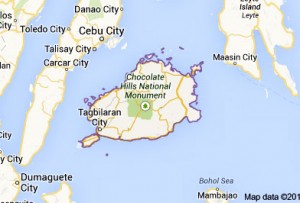Election 2016: Agenda of the Bohol governor
THE INQUIRER is coming out today with the seventh in its series on pressing people’s concerns that should be high on the agenda of candidates for representative, governor or mayor in the May 9 elections. The series should help voters in the provinces choose their leaders wisely. In line with our “ThINQ. Vote.” advocacy, we have asked candidates in certain provinces, cities and congressional districts to outline their concrete plans of action in dealing with specific issues in their areas.
PROFILE: Bohol province
Bohol, in the heart of Central Visayas, is the 10th largest island in the country. The province (population: over 1.2 million), is rich in history, culture and natural resources. It is home to the world’s smallest primate—the tarsier—and to the famous Chocolate Hills.
Bohol relies heavily on tourism for its economic growth, capitalizing on its beaches with sands of varying shades, from blinding white to warm and golden, unspoiled rivers, forests and caves.
Region: Central Visayas
Provincial capital: Tagbilaran City
Land area: 411,726 hectares
Municipalities: 47
City: 1
Barangay: 1,109
Total population: 1, 255, 128 (2010)
Registered voters: 798, 768
Population density:
260/sq km
Annual average family income: P111,000 (as of 2010)
Annual average family
expenditure: P92,000 (as of 2010)
Annual average family savings: P19,000 (as of 2010)
Classification: First class
CONCERN 1: SUSTAINABLE TOURISM
Bohol was known as an ecocultural tourist destination in the country before a 7.2-magnitude earthquake brought it to its knees in 2013. Subsequently, tourism arrivals dropped, crippling the local economy. Stakeholders worked with the government to rehabilitate the tourist spots, but the Provincial Planning and Development Office (PPDO) reported that existing tourist infrastructure and services were still insufficient and had yet to meet tourism quality standards.
Edgar Chatto (Liberal Party)
- Continue ecocultural tourism program of the provincial government grounded in inclusive economic growth for the Boholano community and sustainable tourism development that does not sacrifice the environment, complemented by strong promotion and marketing efforts.
- The new Bohol International Airport will bring in direct flights to and from regional destinations such as South Korea and China, spur the construction of new bridges to address the increased volume of traffic between Panglao Island and main land
- Bohol and pave the way for the construction of more resorts, among others.
- Continue expanding tourism destinations to other areas.
- Continue encouraging and supporting the growth of micro, small and medium enterprises.
Rosemarie Lim-Imboy (PDP-Laban)
- To bring in tourists, restore peace and order.
- Strengthen preservation and conservation initiatives.
- Promote Bohol in all levels and develop tourism in harmony with the natural and cultural environment, through several programs.
- Develop tourism strategic plans that promote environmentally sound and economically, culturally and socially sustainable development.
- Draw up strategic plans to protect the health and safety of tourists, in collaboration with health authorities, tourism operators and security service providers and the police.
- Develop, adopt and implement legislation to promote responsible practices in tourism development.
CONCERN 2: ILLEGAL DRUGS
Illegal drugs are proliferating despite the series of arrests of suspected dealers and confiscation of shabu (methampethamine hydrochloride). Based on reports of the Bohol Provincial Police Office on Dec. 1, 2015, and the Philippine Drug Enforcement Agency, 518 out of 1,109 villages have problems with illegal drugs or have at least one pusher in their area.
Chatto
- Close coordination with PNP, AFP and other law enforcement units for peace, security and public safety. At the heart of it all is a strong and close coordination with the law enforcement agencies of the national government.
- Combat drug problem from two angles—supply reduction and demand reduction. Supply reduction strategies include test-buy, buy-bust, surveillance operations, arrest of persons involved in illegal drugs, confiscation of illegal substances and the filing of cases in court. Demand reduction strategies include drug awareness program/information and education campaign and drug symposiums for barangay offi- cials, parents, teachers and students.
Lim-Imboy
- Establish rehabilitation centers in towns that will also monitor trends in treatment and rehabilitation, as well as issues and concerns that families and recovering drug dependents face.
- Maximize media exposure in antidrug advocacy and enlist more Boholanos in the fight against drugs; encourage all sectors to participate in programs.
- Modernize crime-fighting strategies in Bohol, like putting closed-circuit television cameras (CCTVs) in major thoroughfares.
- Monitor frontline government offices using real-time video and audio surveillance. Bring back special criminal courts to speed up resolution of serious crime cases.
CONCERN 3: POVERTY REDUCTION
Poverty remains a problem in Bohol. The National Statistical Coordination Board in 2010 placed the poverty incidence in the province at 50.2 percent, affecting mostly farmers and fisherfolk. In the same year, it ranked Bohol as the 18th poorest province in the country. The PPDO reported that the widespread poverty in the province had not changed.
Chatto
- Entire development framework is focused on poverty reduction. Programs, strategies and projects are designed to reduce poverty. We have recovered significantly from a high poverty incidence—from 50.2 percent to 30.6 percent in 2012.
- Enforce the HELPS Life (Health, Environment, Leadership Development, Sports and Development, Livelihood and Tourism, Infrastructure, Food Security and Agriculture and Education and Skills Development).
Lim-Imboy
- Limit requirements for business permits to five signatures and impose a 30- to 60-day processing time.
- Establish tourism, agricultural and industrial hubs in the rural areas to create jobs.
- Provide livelihood programs and financial assistance to farmers and fishermen. They may borrow money without interest from the government.

